Pakistani Gold Headpieces
Pakistani Gold Headpieces - Introduction
Pakistani Gold Headpieces: A Regal Tradition
Pakistani gold headpieces—matha patti, tikka, bindiya tikka and jhoomars—are iconic symbols of elegance and cultural heritage. Crafted with intricate designs and often embellished with gemstones, these pieces are worn during weddings and special occasions, embodying beauty and tradition. Each headpiece is a masterpiece, blending timeless craftsmanship with a regal aesthetic.

Pakistani Gold Headpieces - Types
Matha Patti
Kundan Matha Patti
Pearl Matha Patti
Gold Matha Patti
Floral Matha Patti
Tikka
Bindiya Tikka
Borla Tikka
Polki Tikka
Diamond Tikka
Jhoomar
Chand Bali Jhoomar
Traditional Jhoomar
Kundan Jhoomar
Polki Jhoomar
Other than these there are tiaras and small crown like headpieces though not as common in South Asian region as in other parts of the world.
Pakistani Gold Headpieces - Tikka
Description: The tikka is the quintessential piece of head jewelry in South Asian culture. This delicate ornament is designed to be both subtle and impactful, often featuring a pendant that is round, teardrop-shaped, or even crescent-shaped. The pendant is usually attached to a slender chain that is pinned into the hair at the parting, allowing the pendant to rest on the forehead.
Origins: The tikka is deeply rooted in the cultural and spiritual traditions of the region. It is believed to adorn the third eye, symbolizing the wearer’s wisdom and spiritual insight. Over time, the tikka has evolved from a spiritual symbol to a fashionable accessory, becoming a must-have in bridal collections across Pakistan.
Types:
Diamond Tikka: A luxurious option, often used in modern bridal looks, featuring a diamond pendant that adds a touch of sparkle.
Polki Tikka: Incorporates uncut diamonds (Polki) and is typically paired with traditional bridal outfits. Polki tikka is known for its raw, antique appeal.
Kundan Tikka: A contemporary style that is sleek and simple, often chosen for a more understated bridal look.
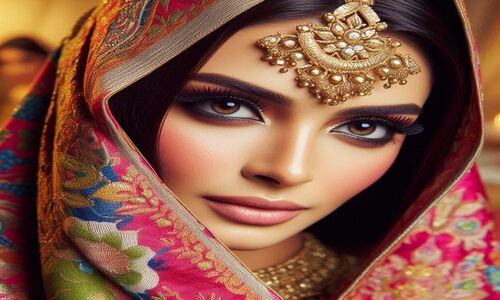
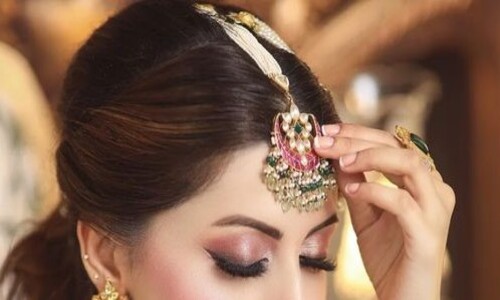
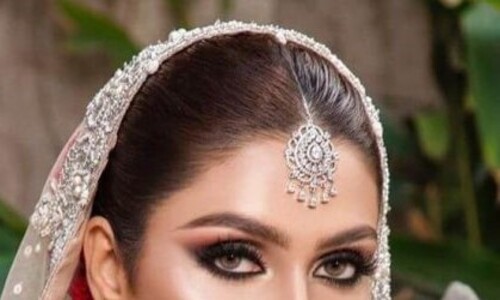
Pakistani Gold Headpieces - Bindiya Tikka
Description: Bindiya tikka combines the elegance of the tikka with the cultural significance of the bindiya, a small dot or jewel traditionally worn on the forehead. The bindiya tikka is usually more delicate than the regular tikka and is designed to complement the bindiya, creating a cohesive look that enhances the bride’s facial features.
Origins: The bindiya tikka is a fusion of Hindu and Muslim jewelry traditions, reflecting the cultural diversity of the Indian subcontinent. It became popular in regions where these cultural traditions intersected, bringing together the simplicity of the bindiya with the ornamental beauty of the tikka.
Types:
Traditional Bindiya Tikka: Often features a small, central pendant that is paired with a matching bindiya, usually in the form of a gemstone or decorative mark.
Layered Bindiya Tikka: Incorporates multiple layers of chains or pendants, creating a more intricate and elaborate design that is ideal for formal occasions.
Pearl Bindiya Tikka: A softer, more romantic variation that uses pearls instead of stones, offering a delicate and timeless look.
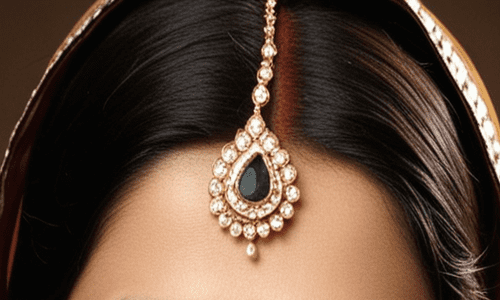
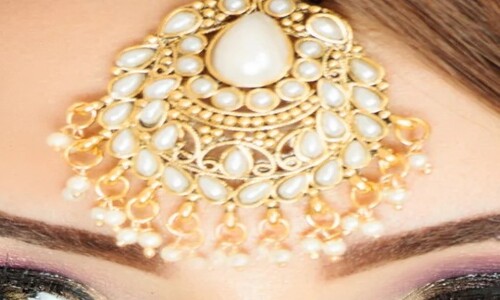
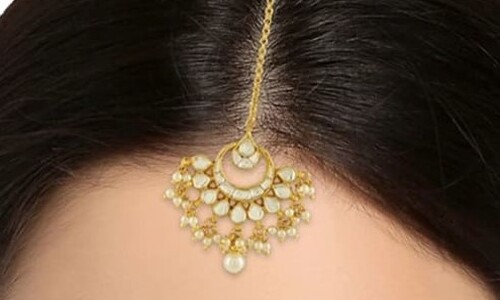
Pakistani Gold Headpieces - Jhoomar
Description: Jhoomar is a side-swept headpiece that adds a touch of vintage glamour to any bridal ensemble. Worn on the side of the head, this crescent-shaped ornament is known for its intricate craftsmanship and the way it cascades down, framing the face beautifully. The jhoomar is typically embellished with a combination of pearls, gemstones, and sometimes, small dangling chains that move gracefully as the wearer moves.
Origins: Jhoomar traces its origins to the Mughal era, where it was a popular accessory among the noblewomen of the time. Its design reflects the grandeur and opulence of Mughal jewelry, with a focus on symmetry and elaborate detailing. In Pakistan, the jhoomar has become a staple in bridal fashion, symbolizing grace and timeless beauty.
Types:
Traditional Jhoomar: Features intricate filigree work with detailed designs inspired by Mughal architecture. This type is often heavy and richly decorated.
Chandbali Jhoomar: Combines the traditional jhoomar with the crescent moon-shaped chandbali design, creating a unique and eye-catching piece.
Modern Jhoomar: Designed for the contemporary bride, this version is lighter and more streamlined, often featuring geometric patterns or minimalist designs.
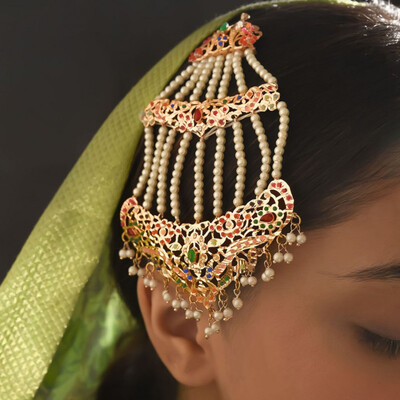
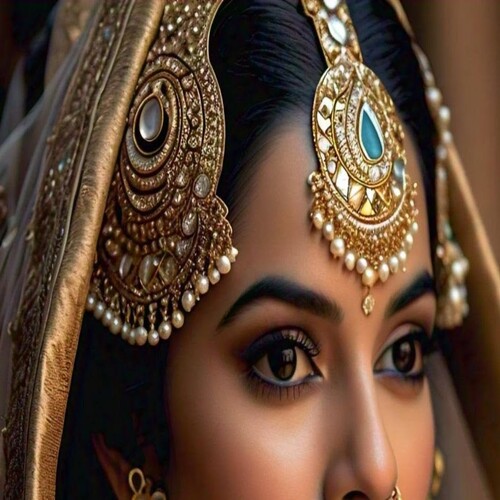
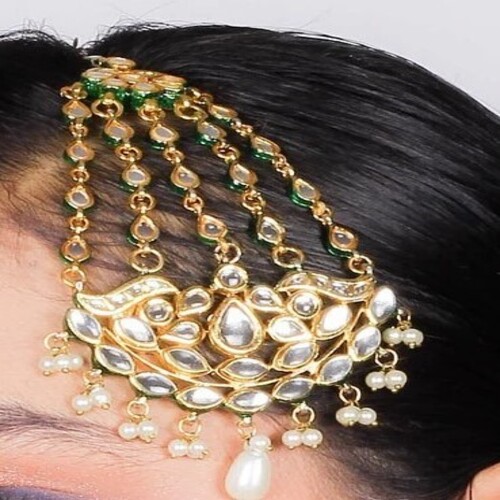
Pakistani Gold Headpieces - Matha Patti
Description: Matha patti is a regal headpiece that elegantly frames the face, making it a statement piece in bridal jewelry. This headpiece is traditionally crafted from gold and is often adorned with precious stones like diamonds, rubies, or emeralds. The central pendant, known as the tikka, rests on the forehead, while the side chains drape along the hairline, connecting at the temples. This creates a halo effect, enhancing the bride’s facial features.
Origins: Originating from the Indian subcontinent, the matha patti has been a symbol of nobility and wealth. It gained popularity during the Mughal era, where it was worn by royal women in elaborate forms. In Pakistan, it continues to be a significant part of bridal attire, symbolizing not just beauty but also the bride’s transition into a new chapter of life.
Types:
Rajasthani Matha Patti: Features intricate gold work and is often paired with traditional Rajasthani bridal attire. This style is known for its elaborate designs and heavy embellishments.
Kundan Matha Patti: Incorporates Kundan stones, which are traditional to South Asian jewelry. These pieces are usually elaborate, with a vintage feel.
Floral Matha Patti: A modern variation that incorporates floral motifs or even fresh flowers, making it ideal for pre-wedding functions like the mehndi.
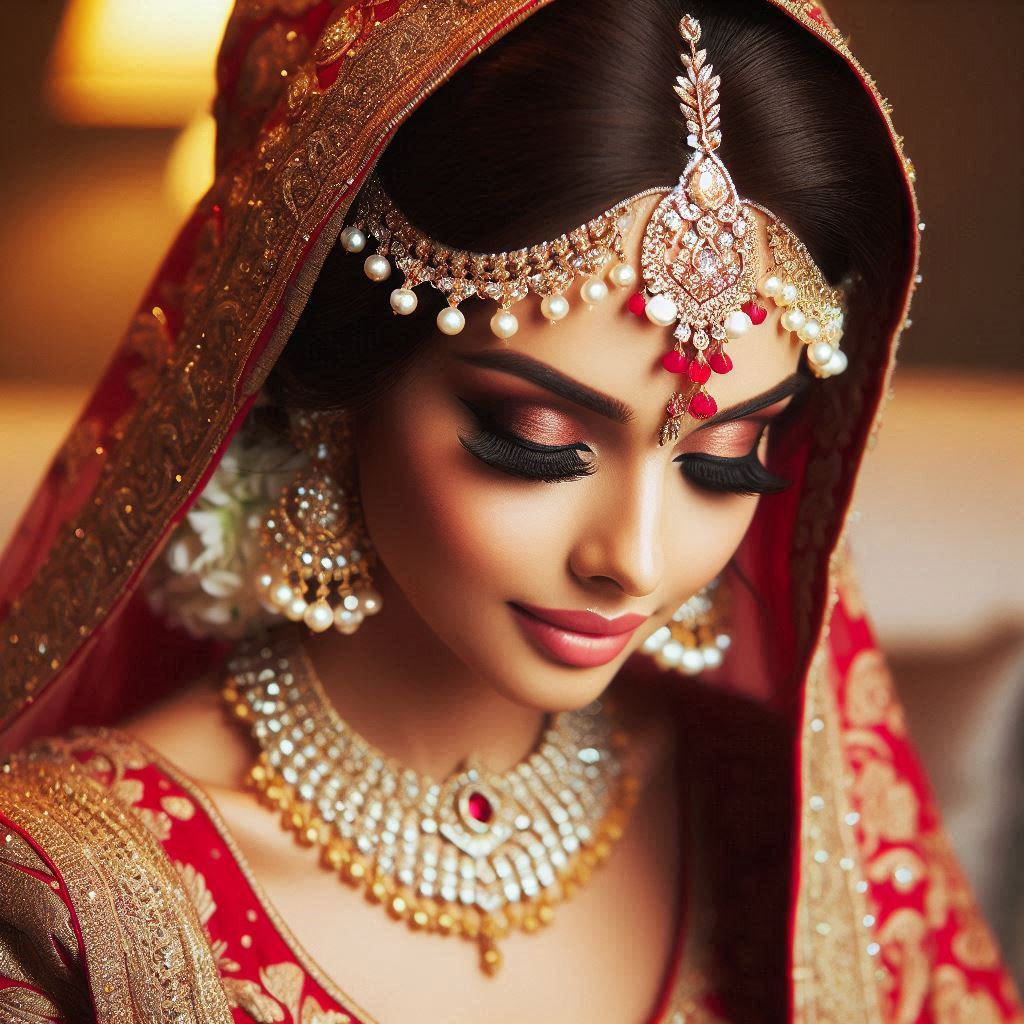
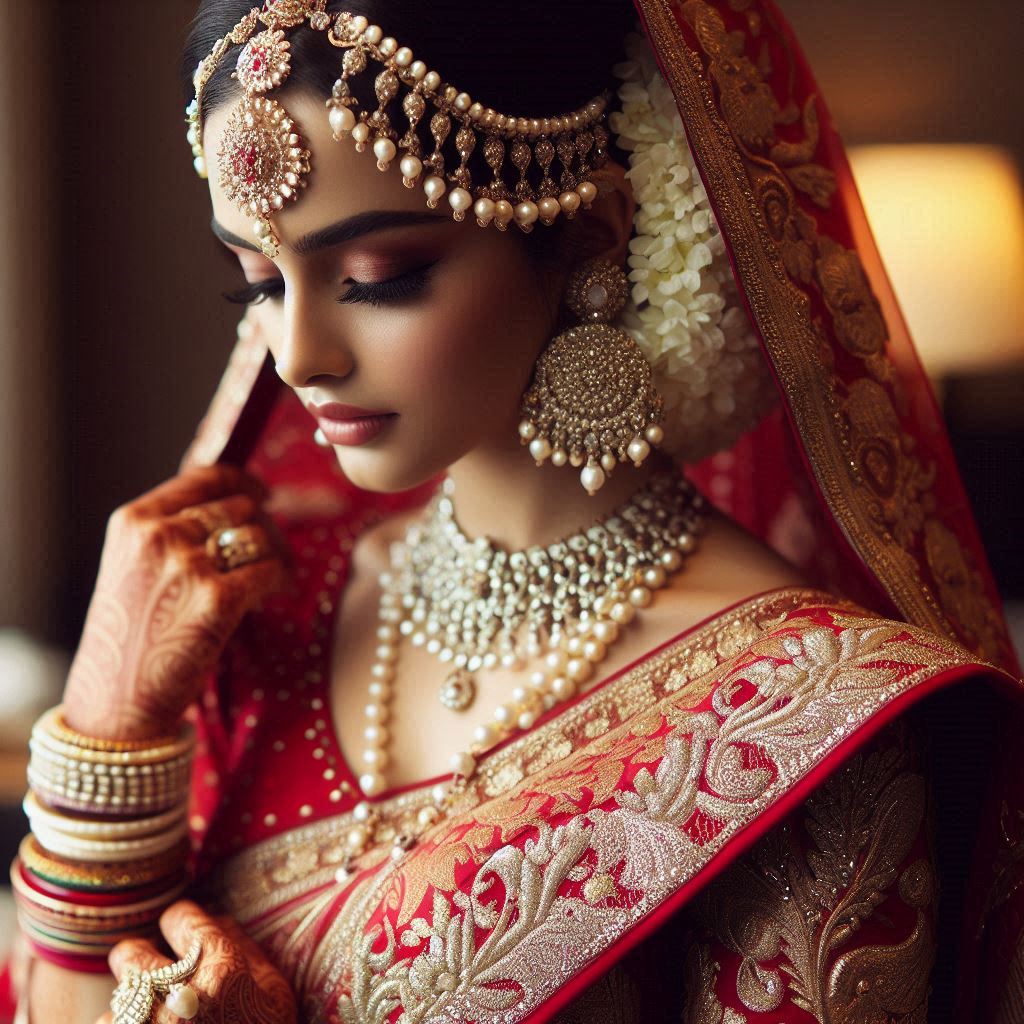
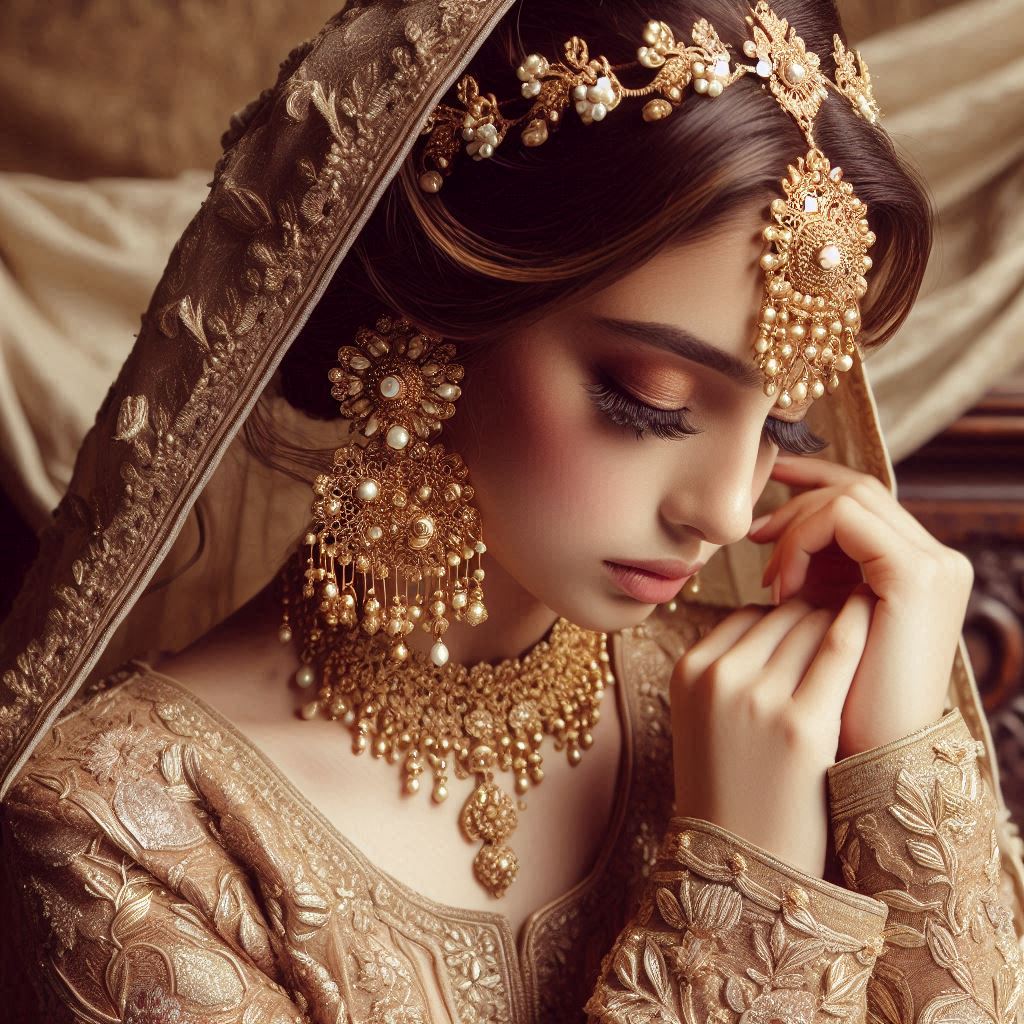
Pakistani Gold Headpieces - Borla or Bolra Tikka
Description: The Borla (or Bolra) is a distinctive dome-shaped headpiece traditionally worn at the center of the forehead. It is typically round and bulbous, resembling the shape of a fruit called "bor," from which it gets its name. The Borla is attached to a thin chain or string that is pinned into the hair, allowing it to rest gracefully on the forehead. This headpiece is often adorned with intricate patterns, gemstones, or pearls, making it both elegant and eye-catching.
Origins: The Borla has its roots in Rajasthan, India, where it has been an integral part of traditional bridal jewelry for centuries. It is particularly popular among Rajput brides and is seen as a symbol of marital status and cultural pride. The Borla has since crossed borders into Pakistan, where it is embraced in regions with strong cultural ties to Rajasthan. It is now a favored accessory in bridal collections, symbolizing heritage and feminine grace.
Types:
Traditional Borla: Features a classic dome shape with detailed gold work, often accompanied by enamel (Meenakari) designs, reflecting the traditional Rajasthani style.
Kundan Borla: Incorporates Kundan stones, which are uncut gemstones set in gold foil. This type of Borla is known for its luxurious appearance and is often paired with other Kundan jewelry.
Pearl Borla: Adorned with pearls, this version offers a softer, more delicate look, making it ideal for brides who prefer understated elegance.
Polki Borla: Uses uncut diamonds (Polki) for a vintage, regal appearance, often chosen for its antique charm and rich history.
Modern Borla: A contemporary take on the traditional design, featuring minimalist patterns and lighter materials, appealing to modern brides who appreciate tradition with a twist.
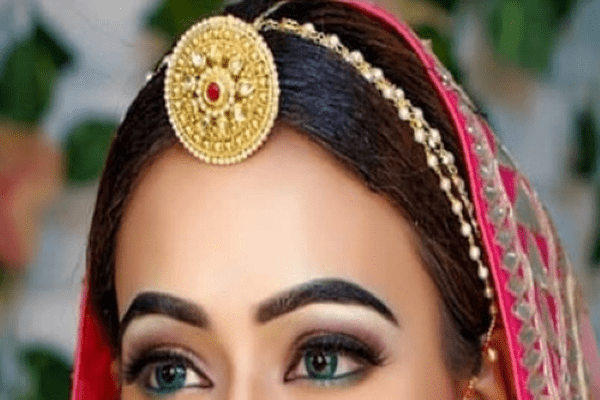
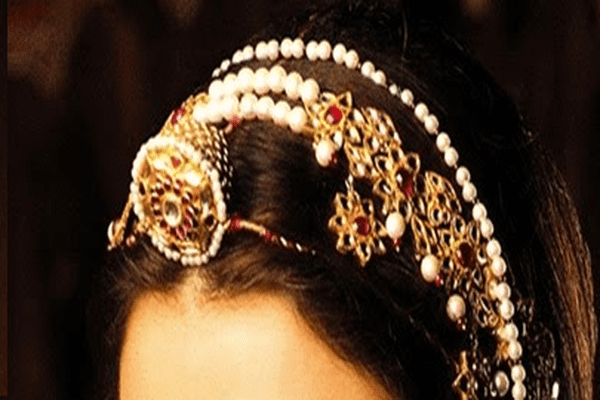
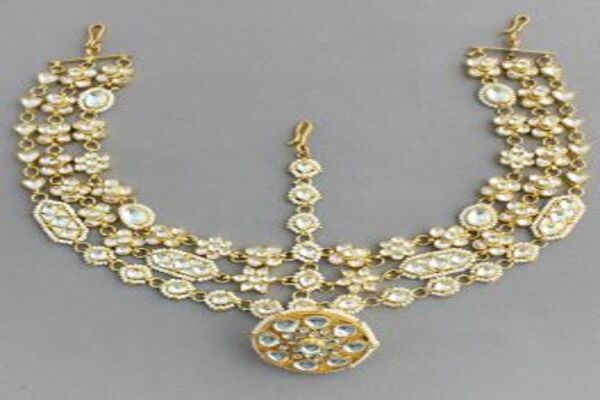
- Home
- Pakistani Jewelry
- Pakistani Gold Headpieces


